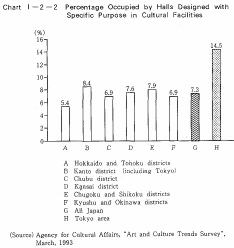| Home > Policy > White Paper, Notice, Announcement > White Paper > JAPANESE GOVERNMENT POLICIES IN EDUCATION, SCIENCE AND CULTURE 1993 > CHAPTER 2 �2 1 | ||
In today's Japan, there seems to be an increased willingness at each level of society to actively participate in cultural activities as a part of daily life. In the "Opinion Poll on National Lifestyles" that was done by the Prime Minister's Office in May 1992. it was discovered that the category of "recreational and leisure activities" has held a high position since 1983 as a factor that the public considers an important part of life. Local government expenditures in the area of culture have increased an average of 15% since fiscal 1985 and amounted to 482.600 million yen in fiscal 1989.The number of cultural facilities has also increased greatly, with the establishment of 934 civic centers by local governments in 1990.
In recognition of the vital importance of cultural promotion to the development of richly unique regional cultures, many local governments are strongly promoting special projects to this effect.
According to the "Culture Consciousness Survey", opportunities to enjoy viewing art increase in proportion to the size of the city in which an inhabitant lives (Chanter l, Chart I-l-8). Chances to enjoy art are also unevenly distributed throughout the different localities, in that. More opportunities to enjoy art exist, for example, in the Kanto region than in the Hokkaido or the Tohoku region.
Civic centers provide a base for cultural activities existing close residents of the local community; however, because as many as 20 % of these buildings were constructed nearly 30 years ago and are in need of repair or replacement. There is a growing expectation on the part of citizens for improvements in the buildings and equipment. Many have expressed interest in increasing the quantity of the cultural programs provided, such as the inclusion of more concert programs. There are then, various expectations being placed on civic centers, both in terms of physical facilities ("hardware") and in terms of the programs provided within these facilities ("software").
Urged on by the recent strong demands of the communities, gradual construction of high caliber, specially designed halls has been taking place. The majority of halls, however, remain multi-purpose, with the number of halls designed with a specific purpose in mind still being low and not located with in easy physical access of the average citizen. In February 1993, the Agency for Cultural Affairs commissioned a private research agency to conduct a "Survey Concerning the Trends of Art and Culture in Japan"(hereafter referred to as the "Art and Culture Trends Survey"). According to the results of this survey which covered all national, local public and private civic centers and cultural halls as well as public and private art museums in Japan. as can be seen in Chart l-2-2, a disproportionate percentage of the above-mentioned type of specially designed hall are located in the Tokyo area, indicating an uneven distribution with respect to the localities. The number of people in the localities who desire that high quality performances take place at facilities located in their regions is not few. There is then. a necessity to build halls that are specially designed for a specific purpose while taking their proportionate distribution into consideration. Besides the actual physical facilities themselves, improvements are also needed in the area of "software", such as for example, the carrying out of self-managed projects and better training for staff members.
Local government policy (including the establishment of civic centers)plays an important role in promoting local cultural activities. In order to maintain and enliven the people's original spirit as expressed in the local artistic and cultural activities, the Agency for Cultural Affairs provides guidance and assistance to local governments as they carry out an increasingly rich array of programs and policies for the promotion of cultural activities. The Agency is also endeavoring to cooperate with local governments to create environments in which the members of the local communities can take part in long life cultural activities in then neighborhoods in which they live.
Each year, the Agency for Cultural Affairs splits the country up into a few districts for a "Cultural Promotion Conference", to exchange opinions with respect to the promotion of community culture. The Agency has also been improving the system for promoting creative community cultural activities by instituting a "Regional Culture Office" in fiscal 1989, and since fiscal 1990, by conducting investigations and research concerning the establishment of a local cultural information system which would assist in the collection and distribution of information needed to promote community development through the fostering of its culture. In the face of increasing demands for the promotion of local culture, these systems need to be improved in order to facilitate an even greater degree of collaboration and cooperation with local governments.

| Back to Top | MEXT HOME |